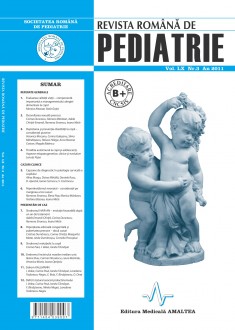SELECT ISSUE

Indexed

| |

|
|
|
| |
|
|
|

|
|
|
|
|
|
|
HIGHLIGHTS
National Awards “Science and Research”
NEW! RJP has announced the annually National Award for "Science and Research" for the best scientific articles published throughout the year in the official journal.
Read the Recommendations for the Conduct, Reporting, Editing, and Publication of Scholarly work in Medical Journals.
The published medical research literature is a global public good. Medical journal editors have a social responsibility to promote global health by publishing, whenever possible, research that furthers health worldwide.
HAIR-AN syndrome – favorable outcome after one year treatment
Adela Emandi Chiriţă, Corina Duncescu, Ramona Stroescu and Ioana Micle
REZUMAT
Introduction: HAIR-AN syndrome is a subphenotype of polycystic ovary syndrome and is characterized by hyperandrogenism (HA), insulinresistance (IR) and acanthosis nigricans (AN) associated with obesity. It is not a rare disease. The annual incidence worldwide is estimated at around 5% of adolescent girls. Undiagnosed and untreated insulin resistance is linked to long-term complications, such as coronary artery disease, dyslipidemia, and diabetes.
Aim: We report a case of HAIR-AN syndrome in an adolescent girl with favorable outcome after one year of treatment.
Methods: The patient presented at 14 years 10 months with obesity, acanthosis nigricans, hirsutism, acne and irregular menses. She received recommendations for weight loss and treatment with metformin, progesterone, cyproterone acetate and topic agents for acne. She came regularly to follow-up every 3 months.
Results: Her blood pressure was normal for age. Her blood work revealed insulin resitance (HOMA-IR = 6,38) and elevated DHEAS. Abdominal ultrasound showed polycystic ovary. After 3 month of treatment the insulin resistance was substantially reduced, while her hirsutism, testosterone and DHEAS increased dramatically, with decrease of SHBG. At that moment we performed abdominal MRI, that infirmed the presence of adrenal tumor or adrenal rest tumors in abdomen. We increased metformin dosage (2 g/day) and continued to offer counseling to improve weight loss (psychologist involvement). After one year, her BMI decreased by 6.6 kg/m2 , along with her insulin resitance and androgen levels.
Conclusions: Early diagnosis and treatment of HAIR-AN syndrome may improve the quality of life of patients and decrease risk of future complications. Weight loss has a major impact on metabolic parameters.
Key words: HAIR-AN syndrome, adolescent, metformin, polycystic ovaries syndrome
